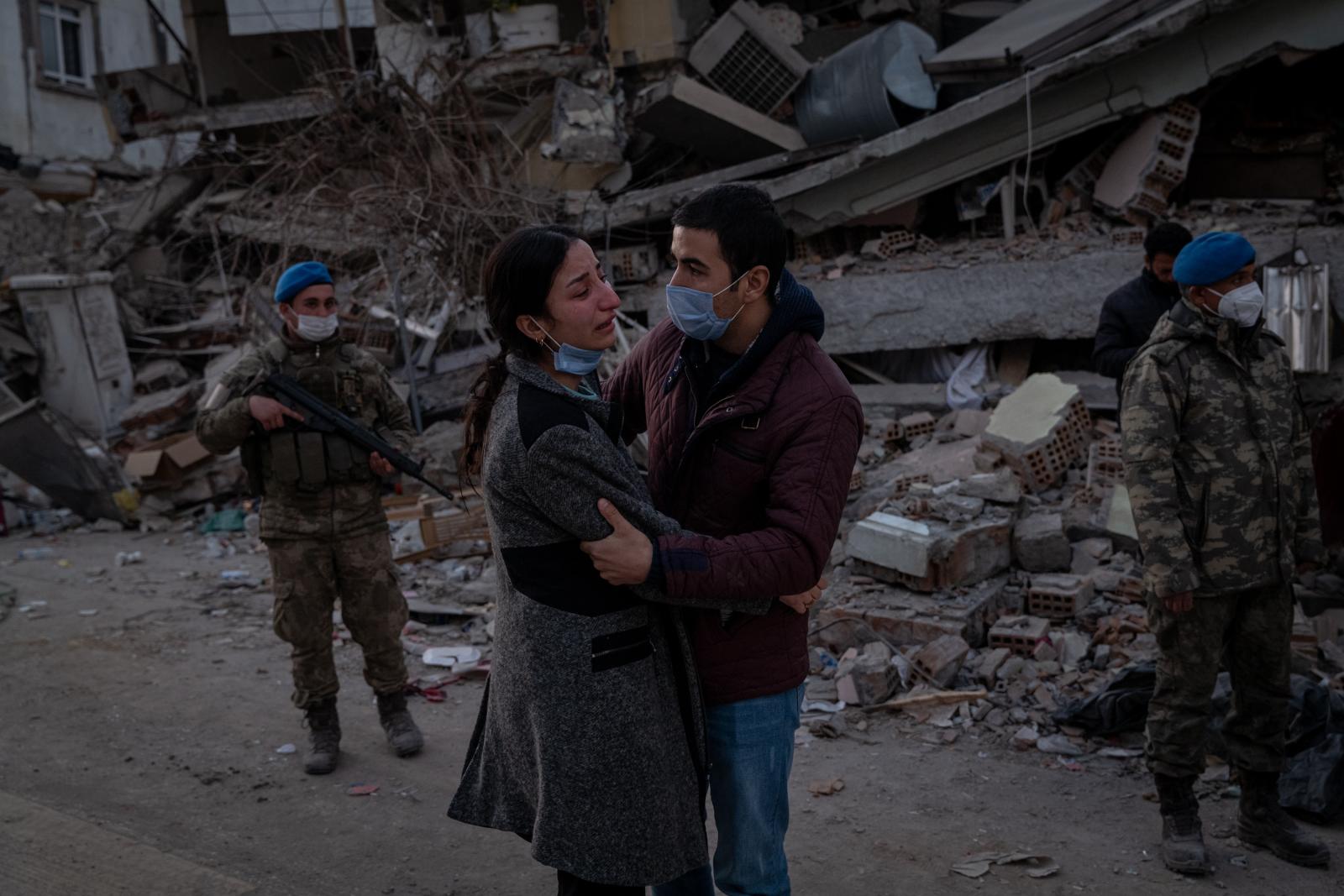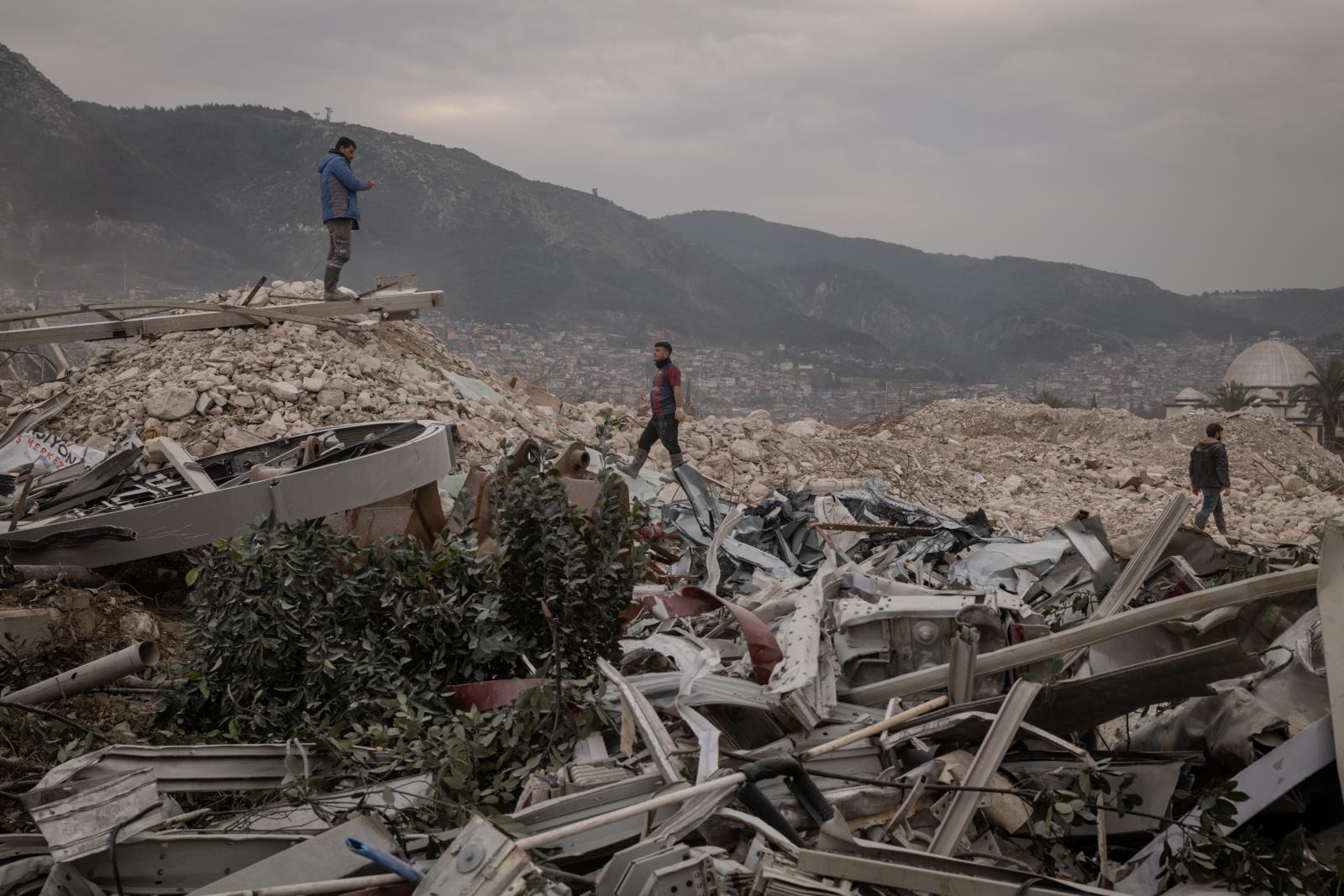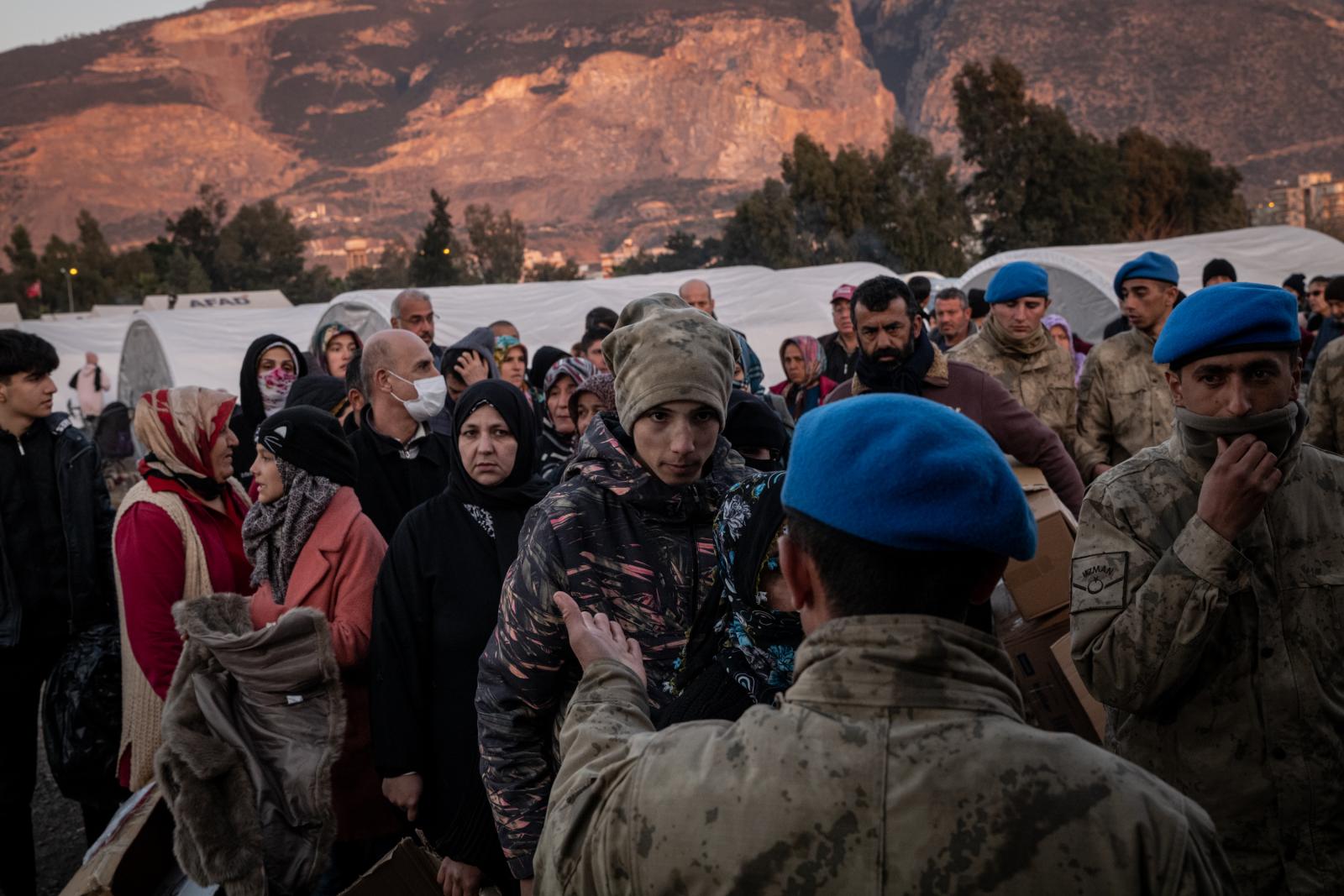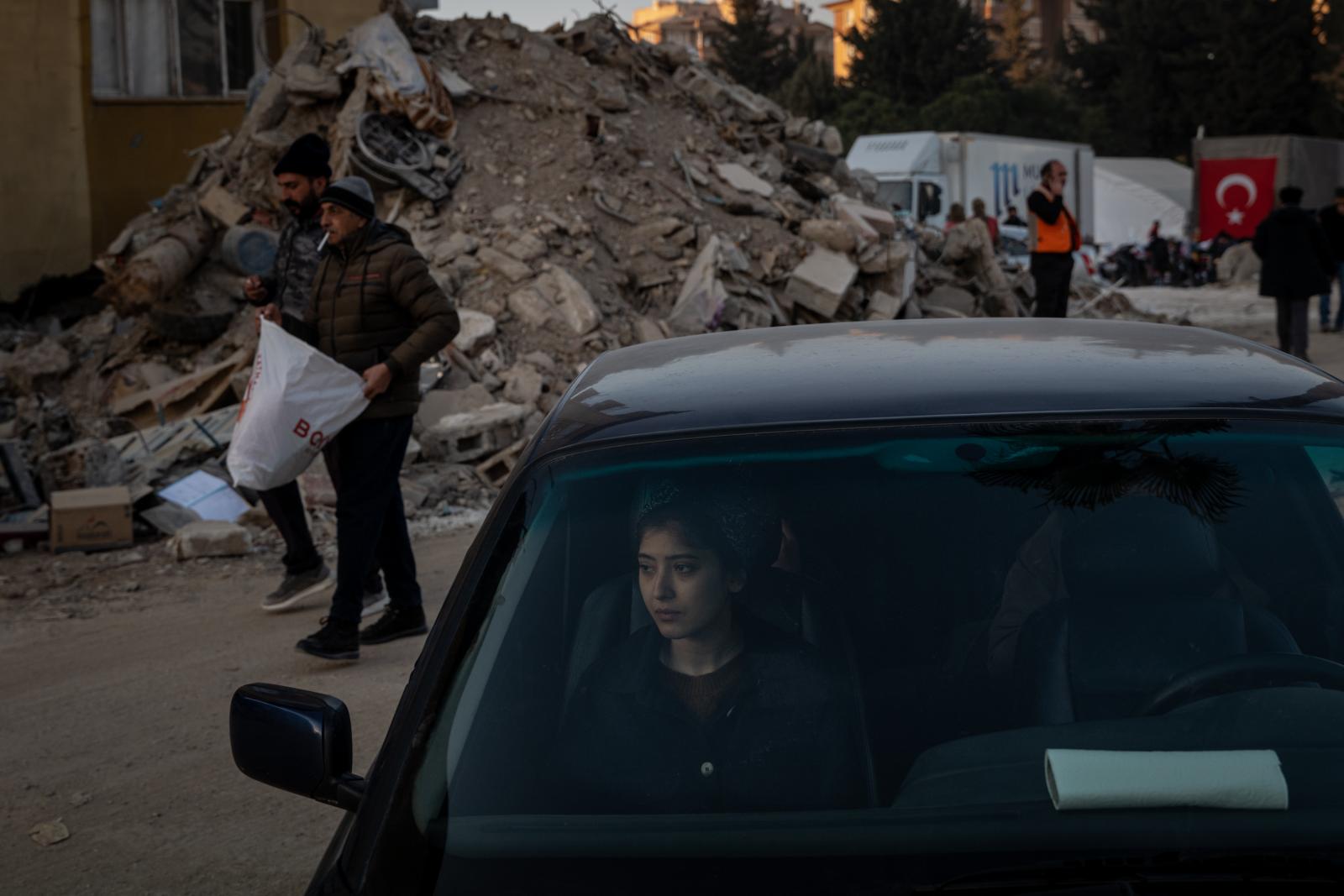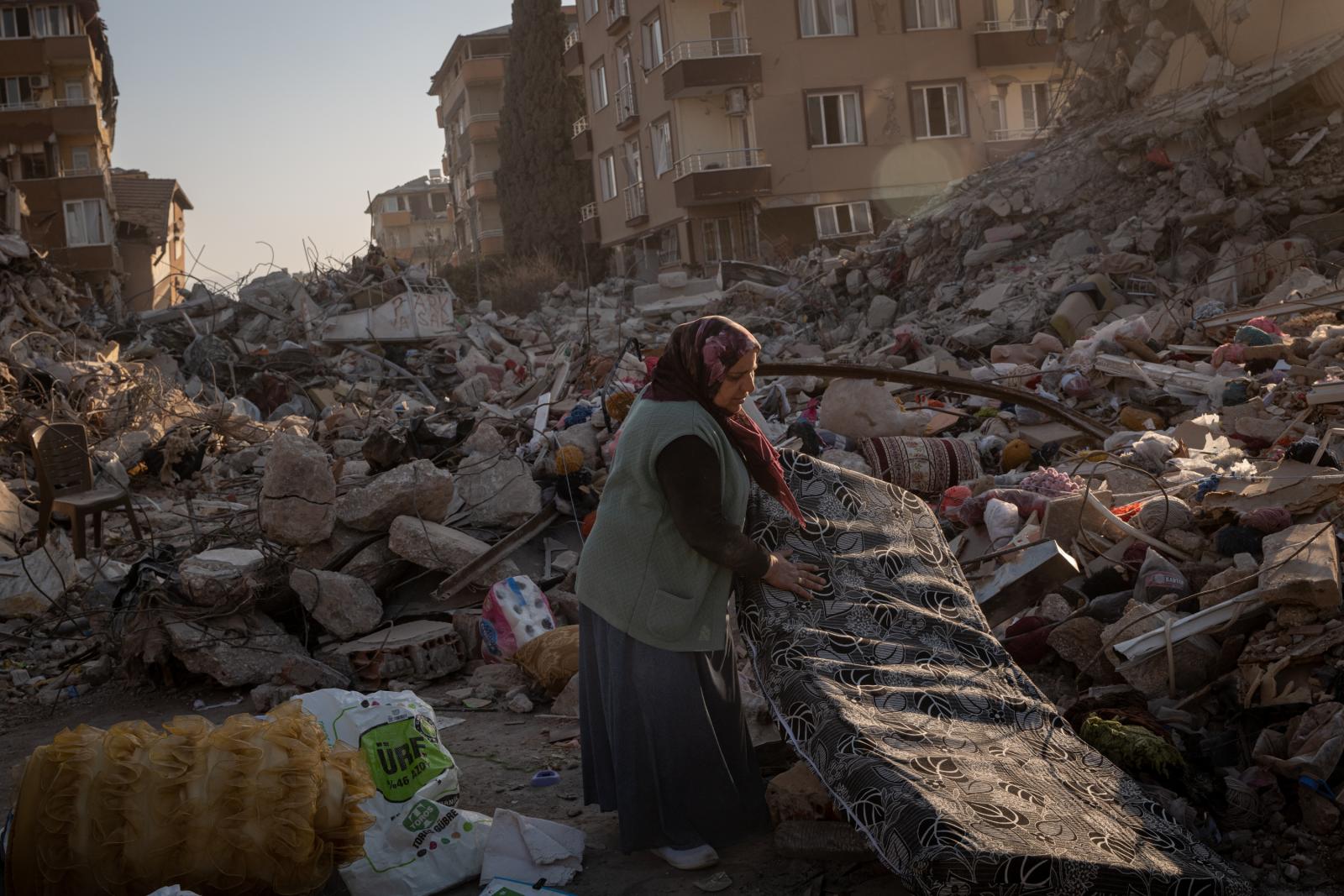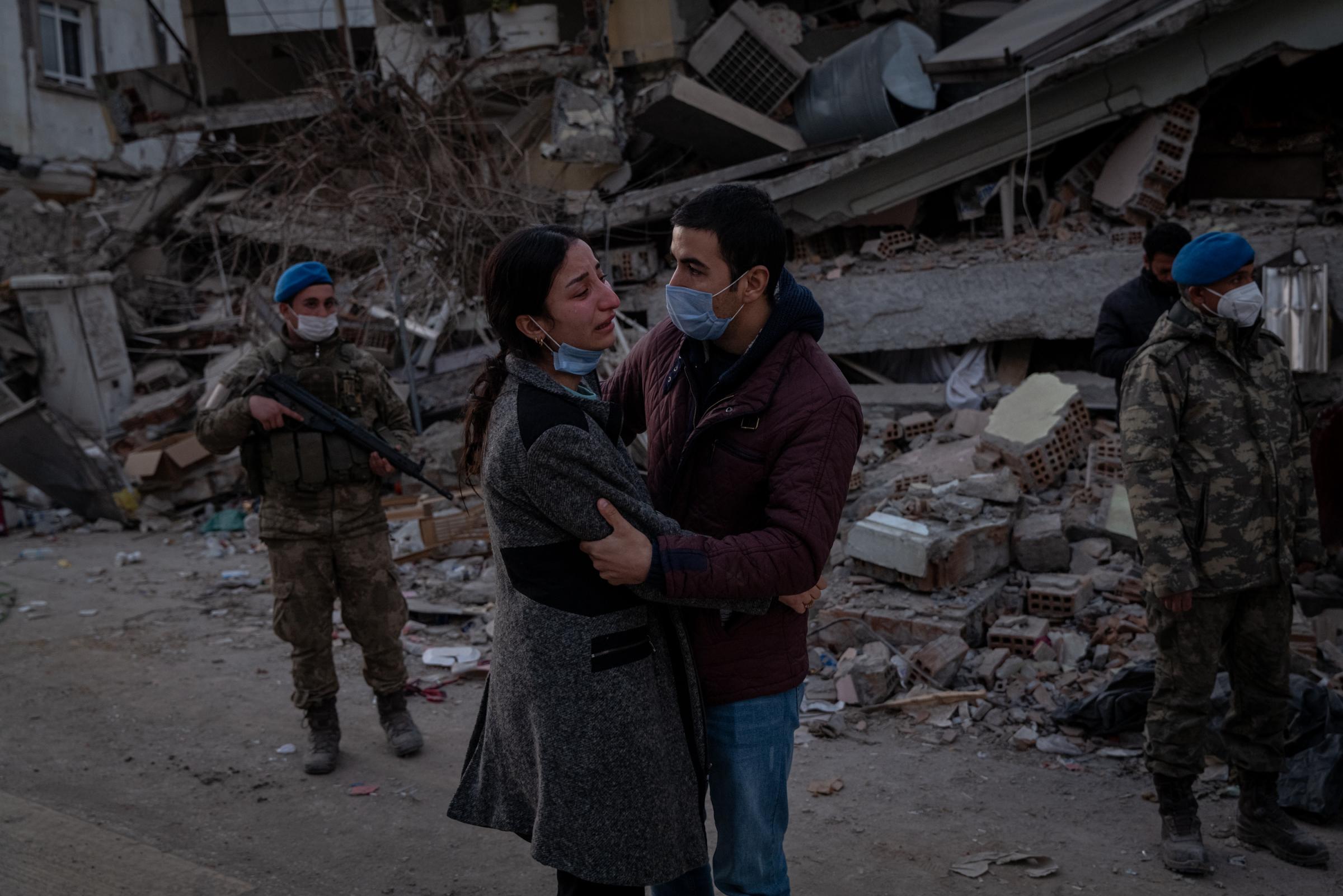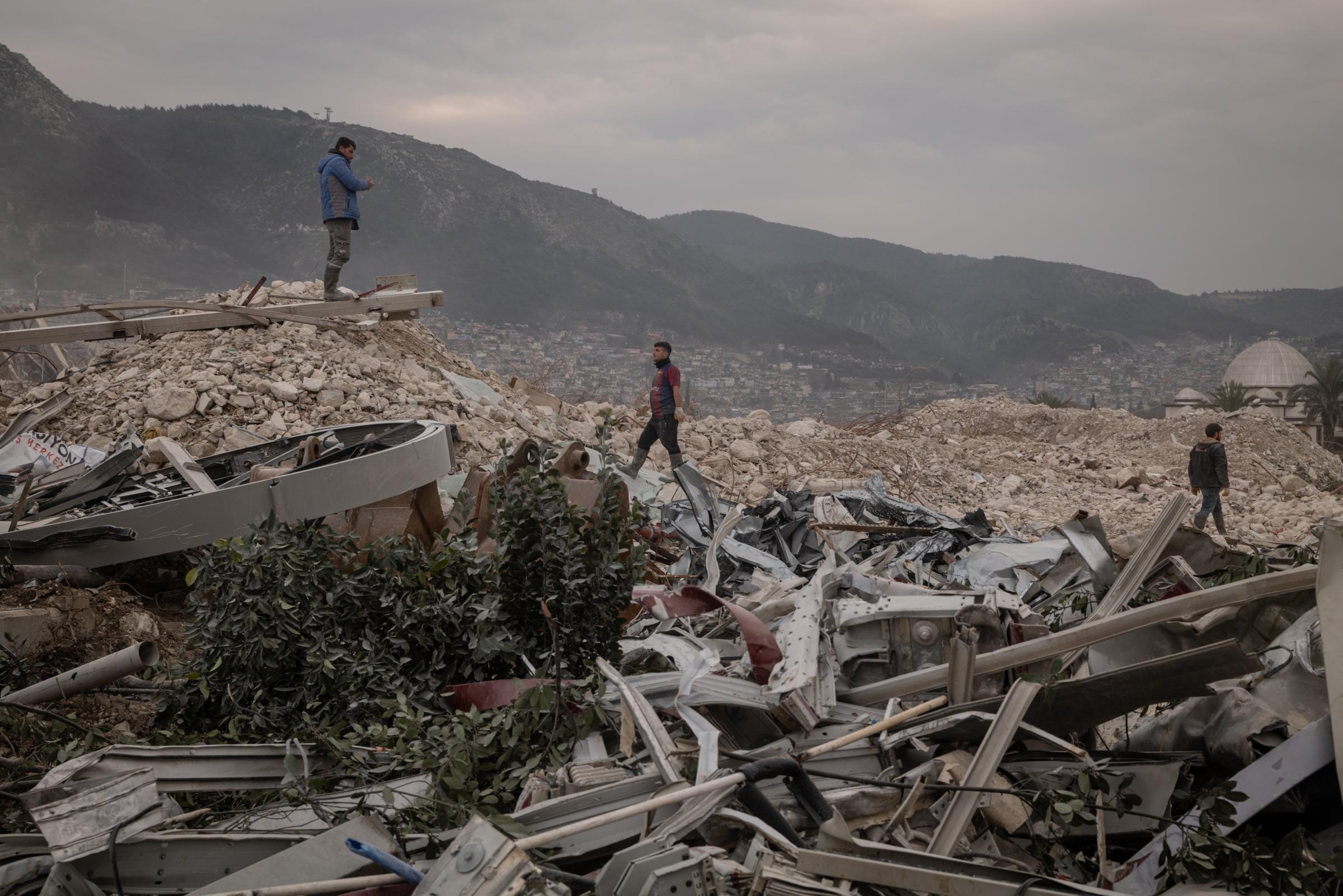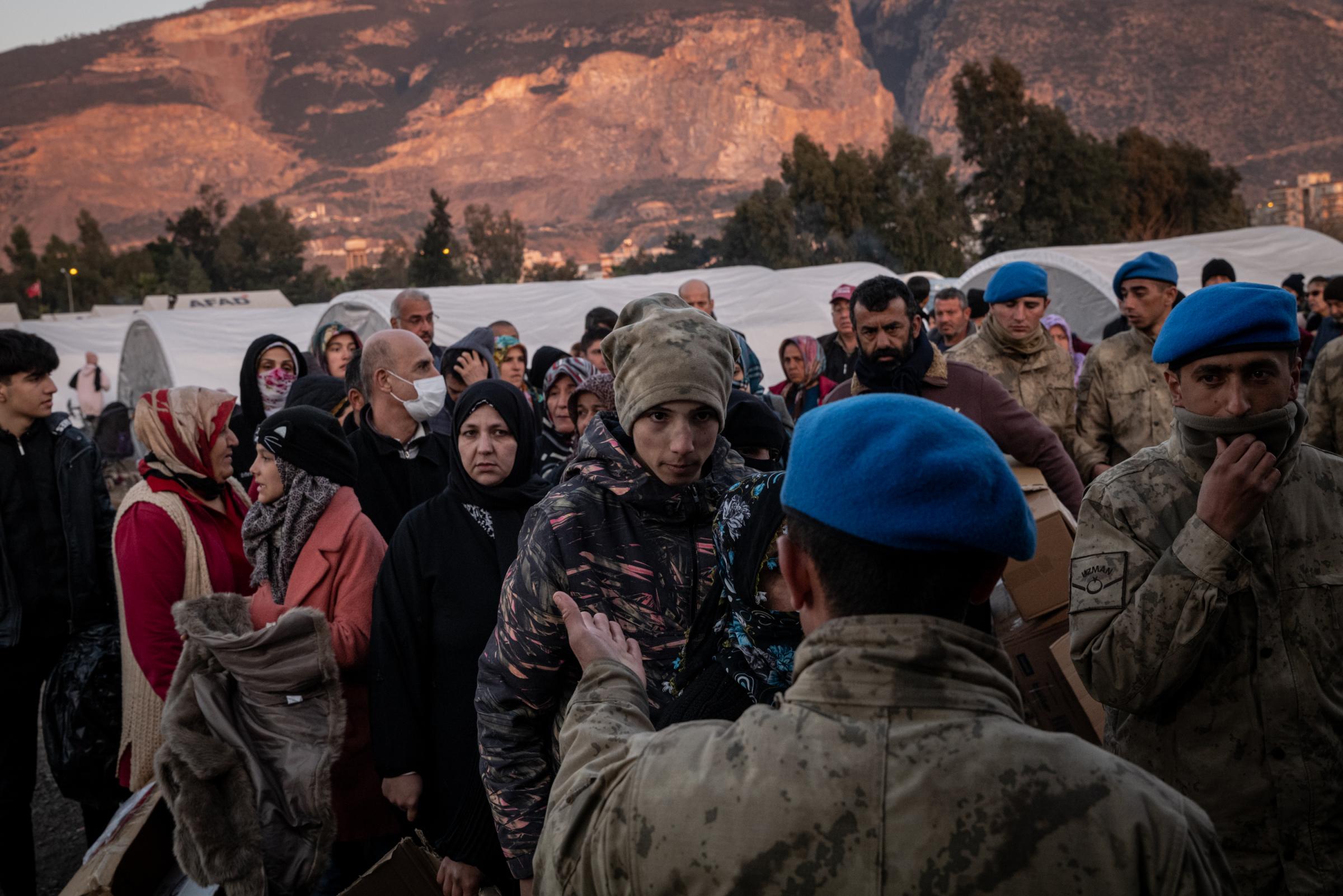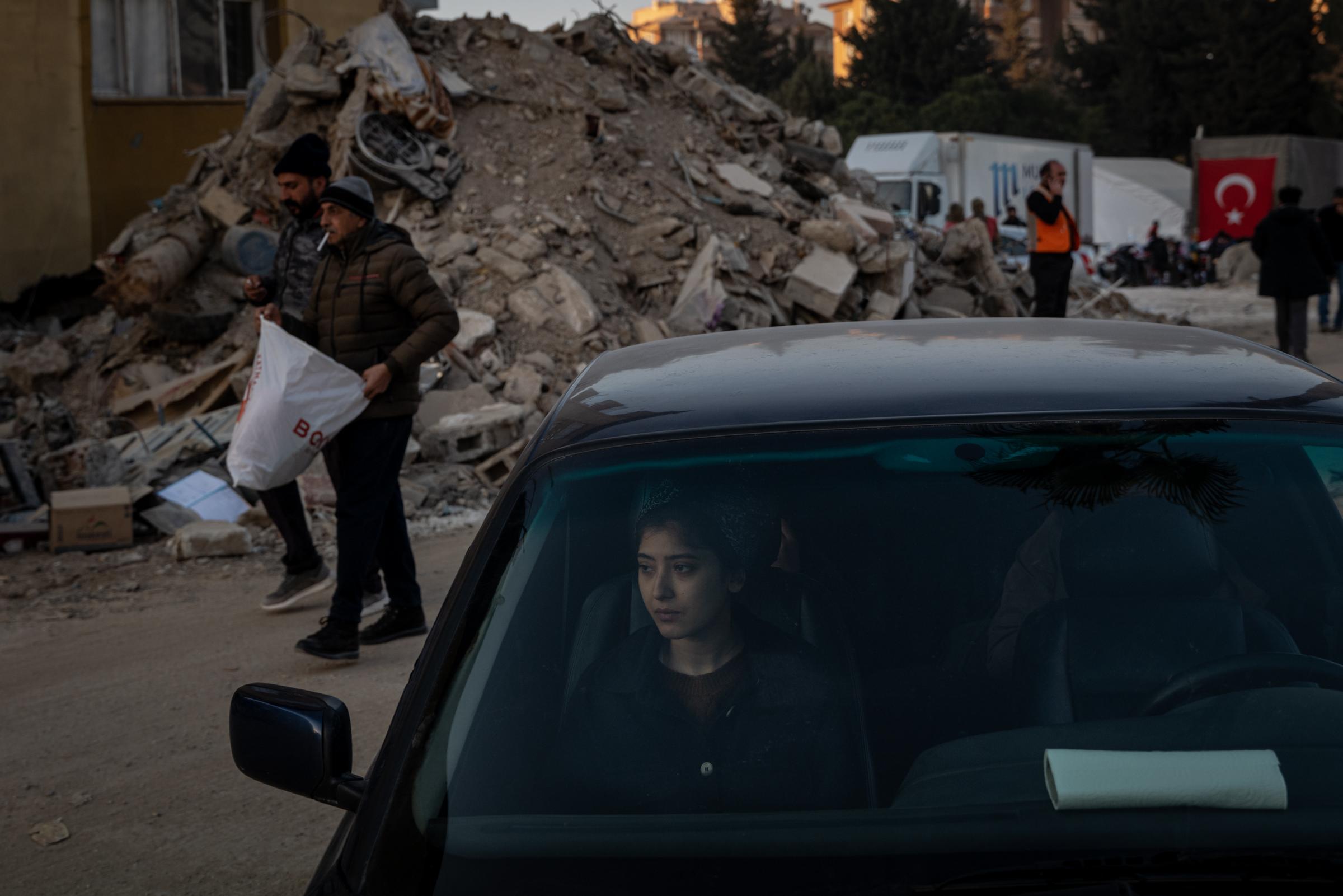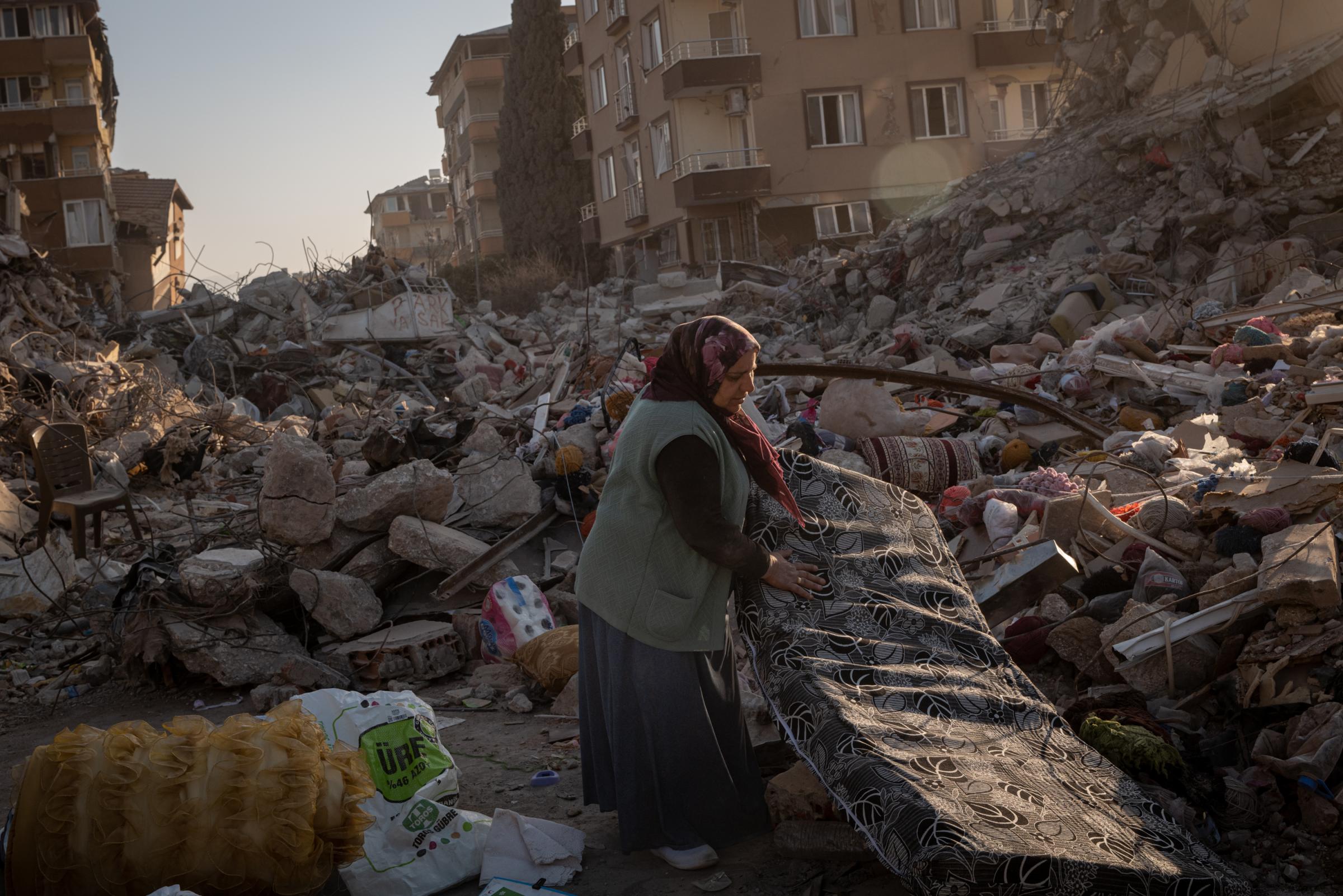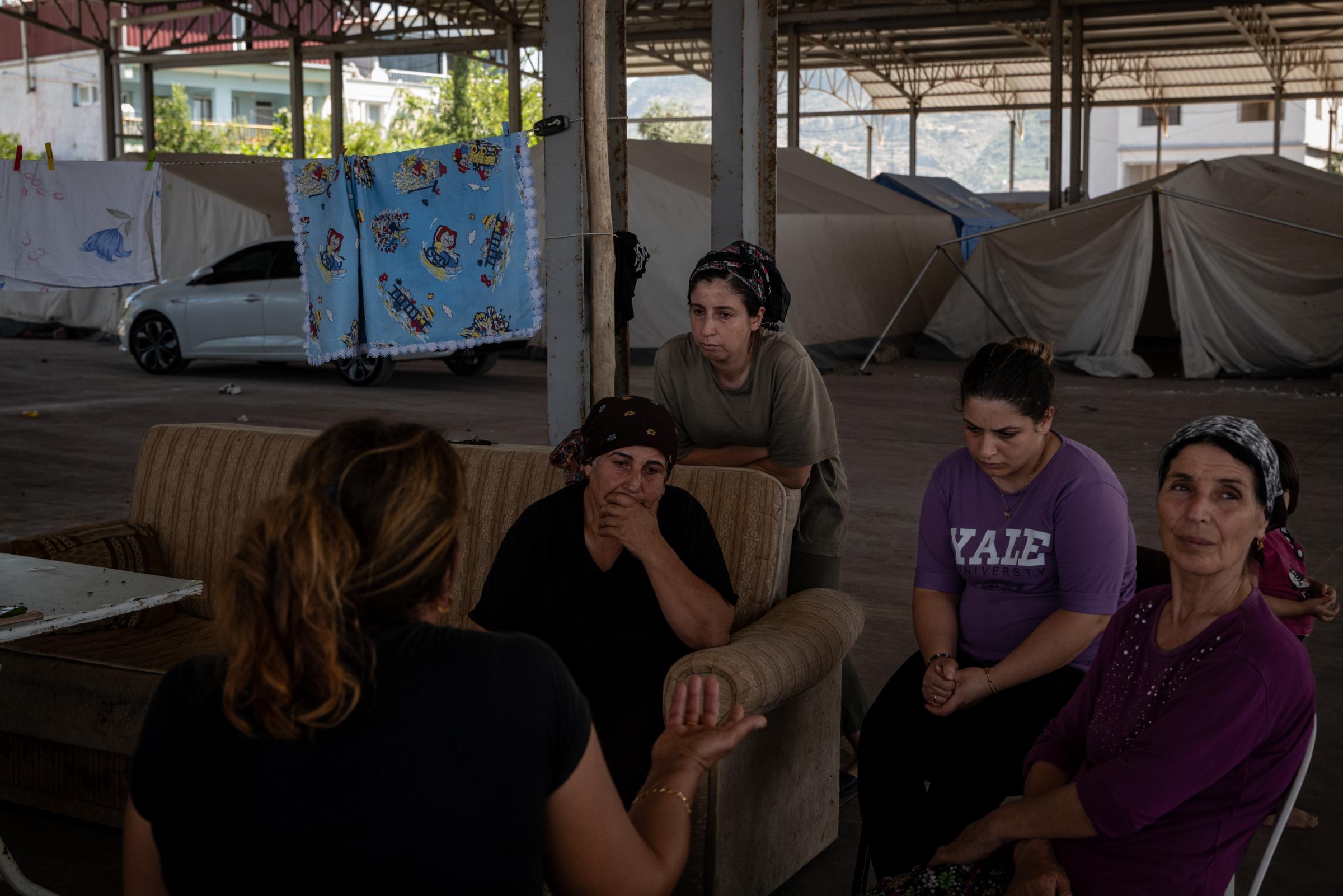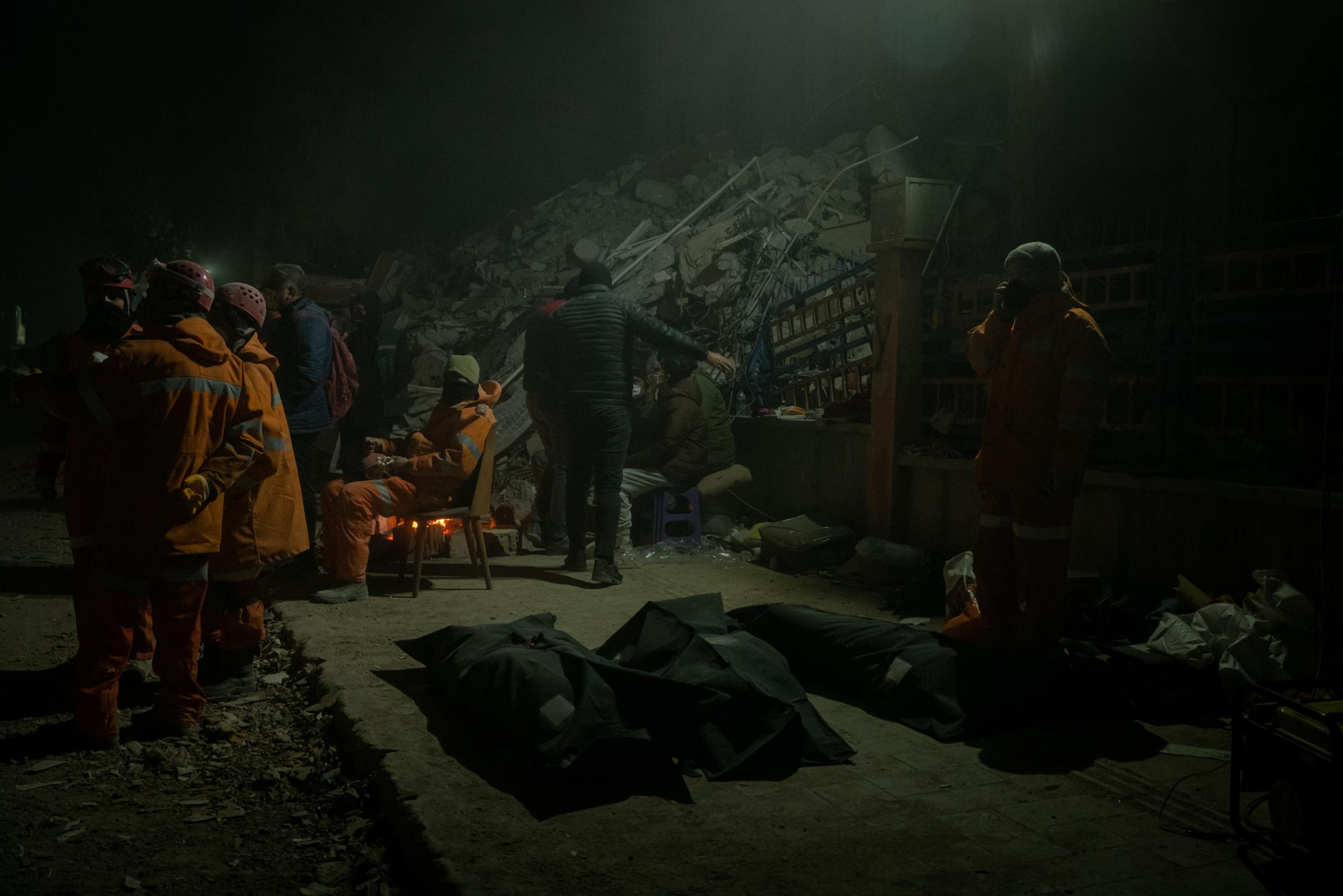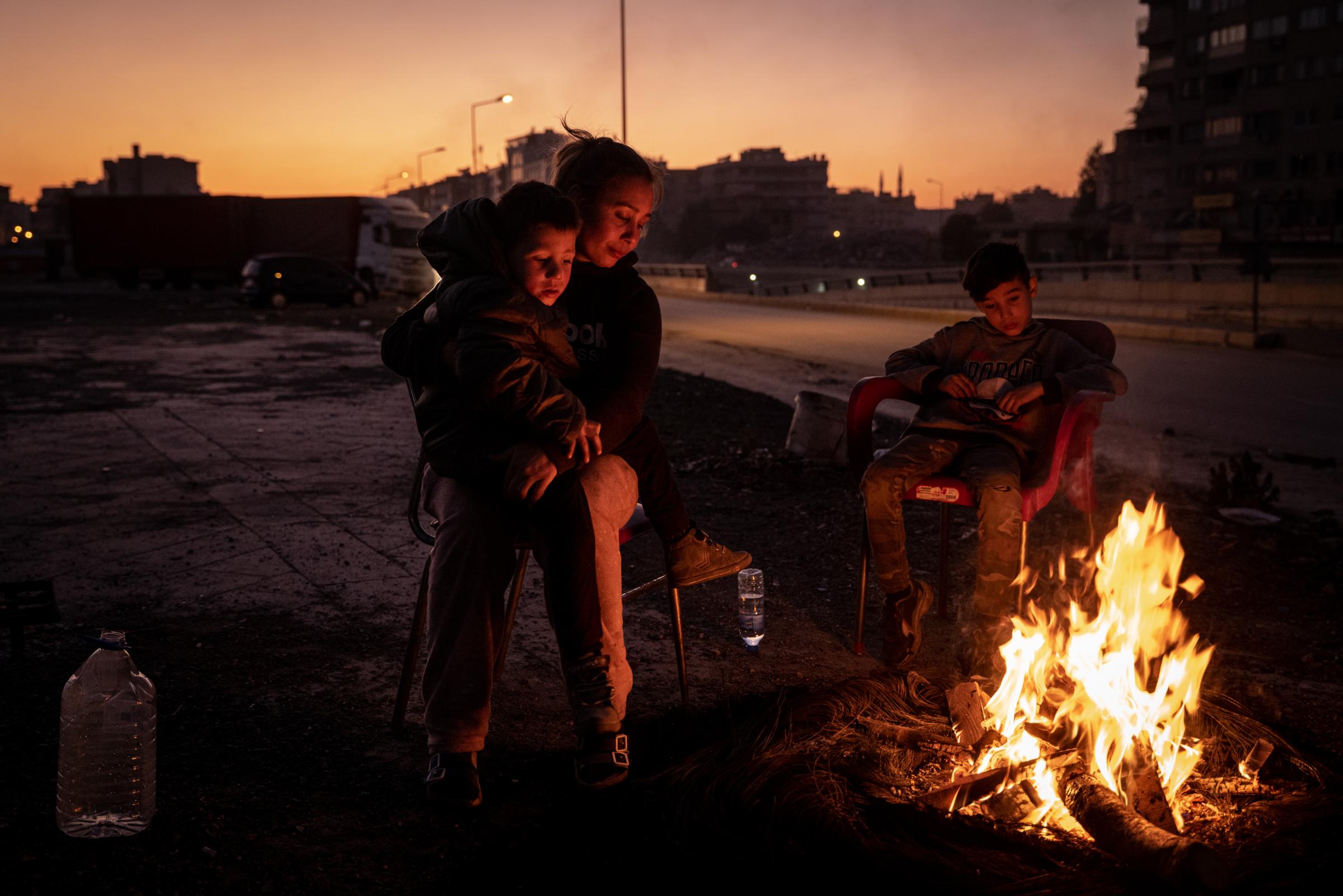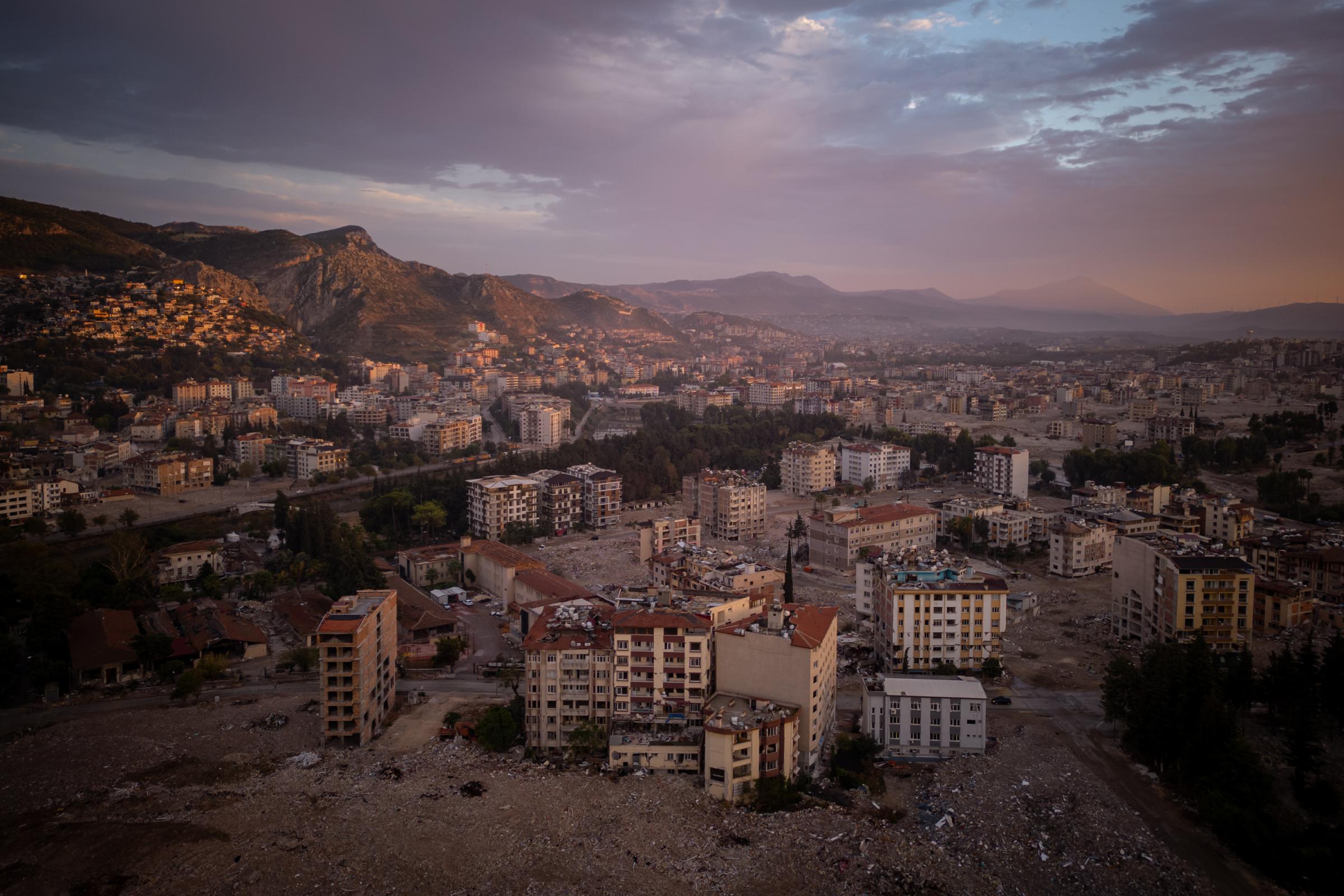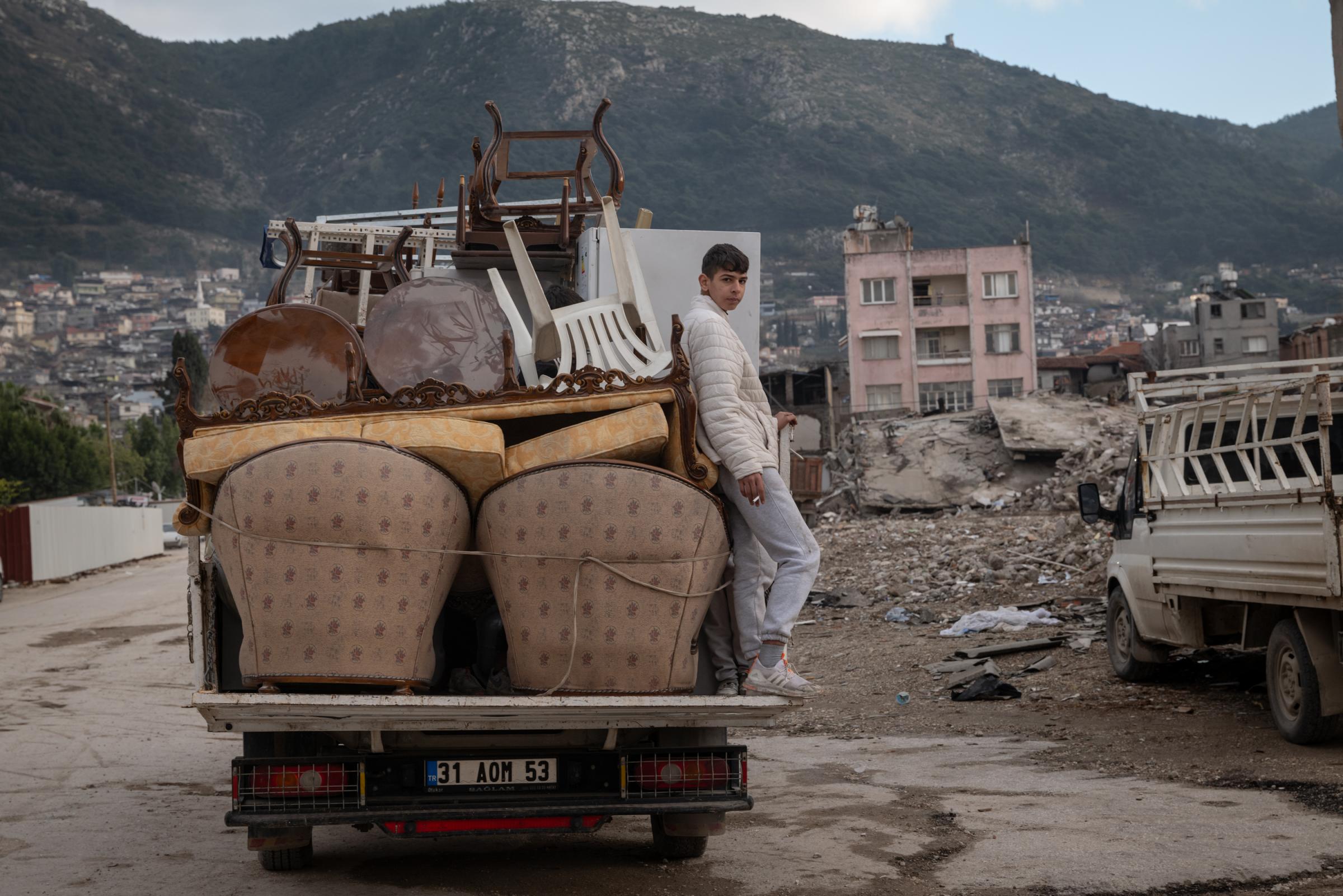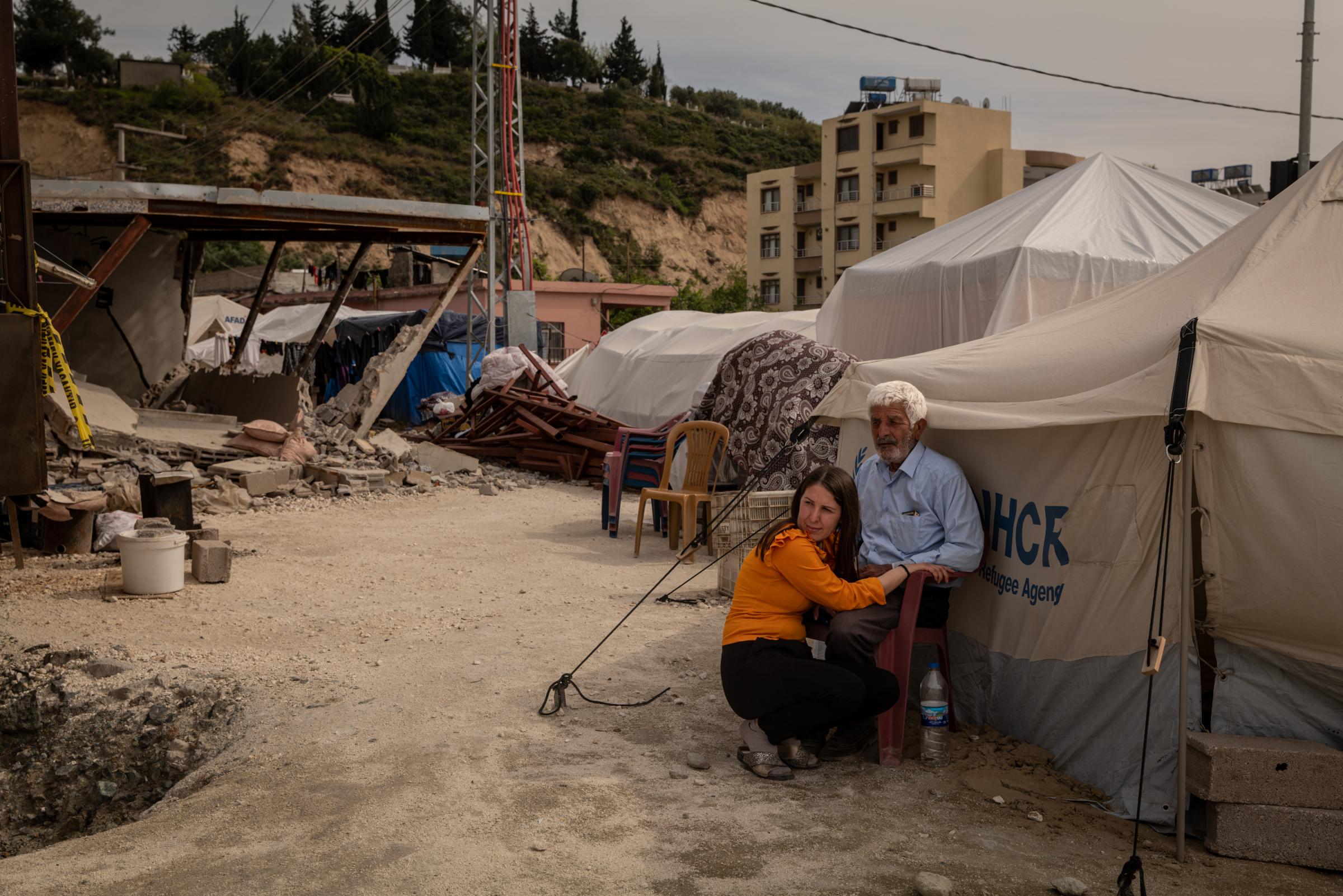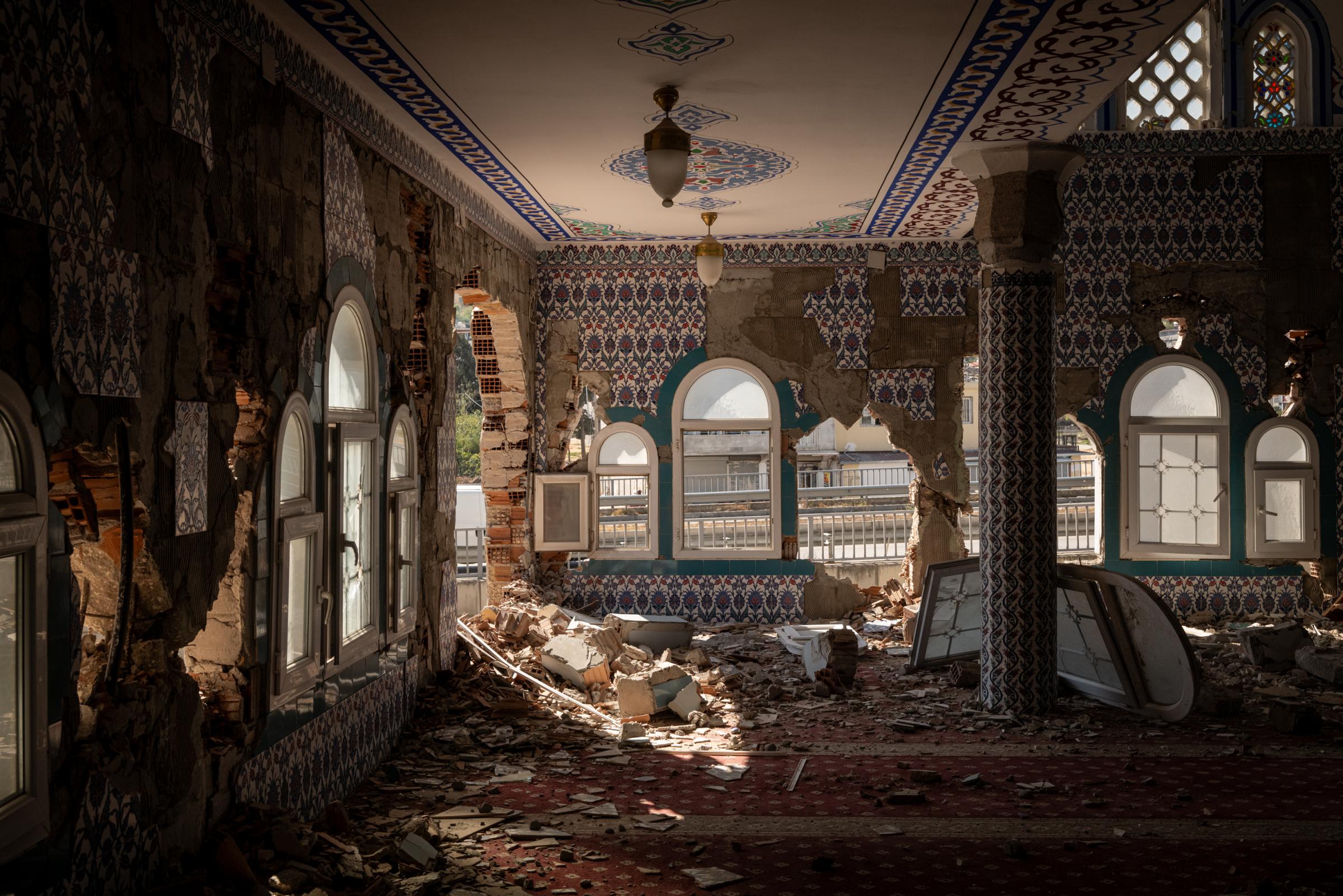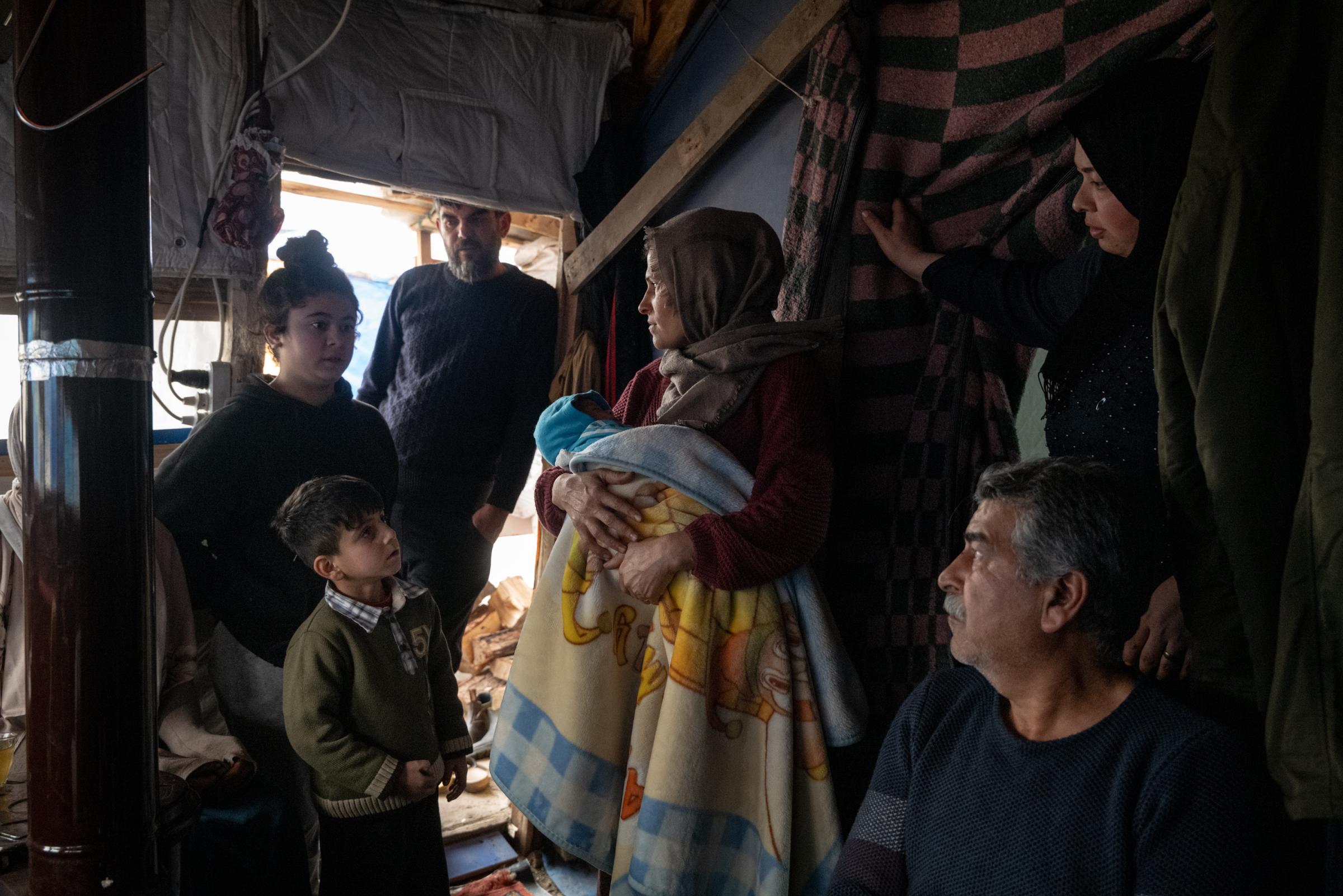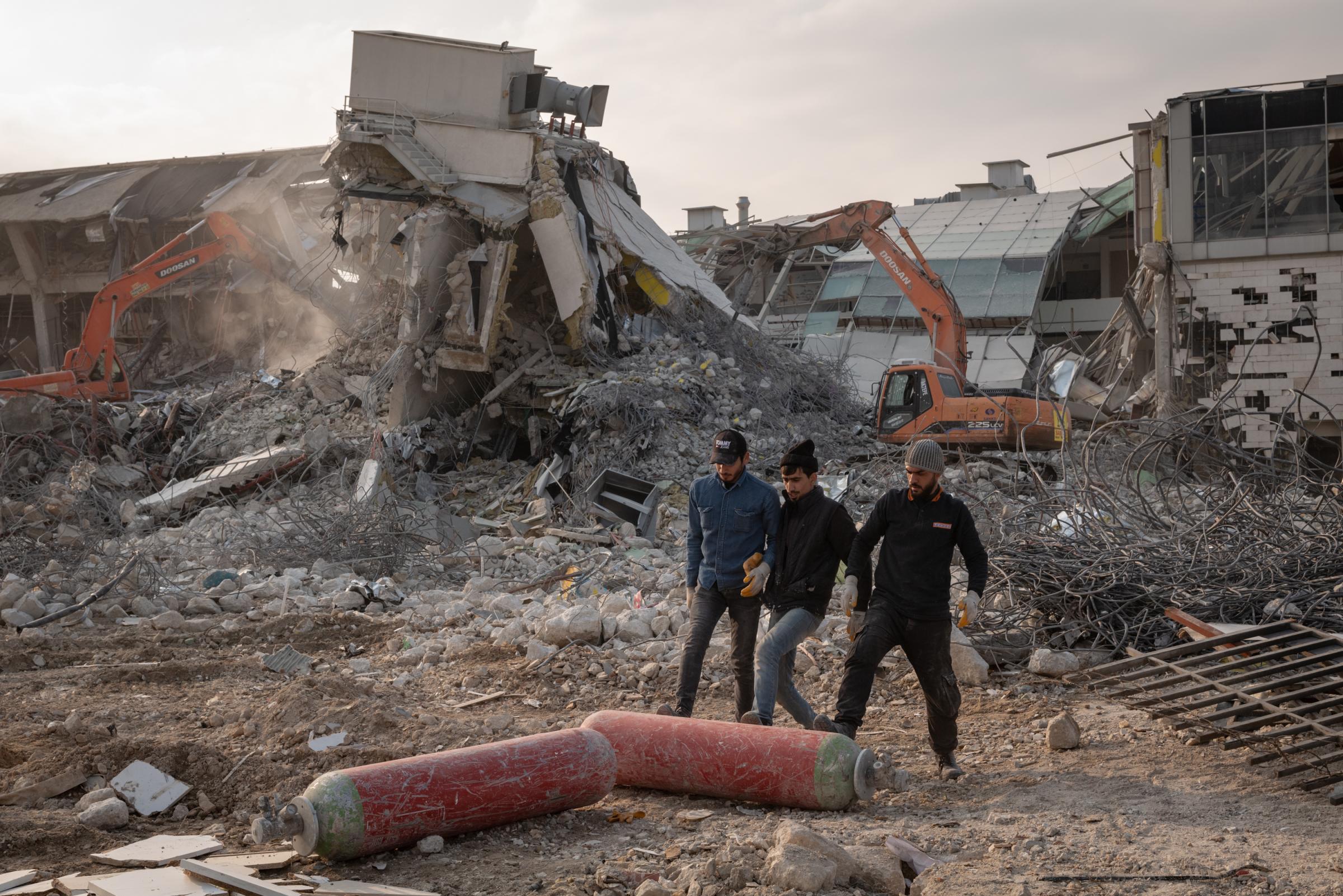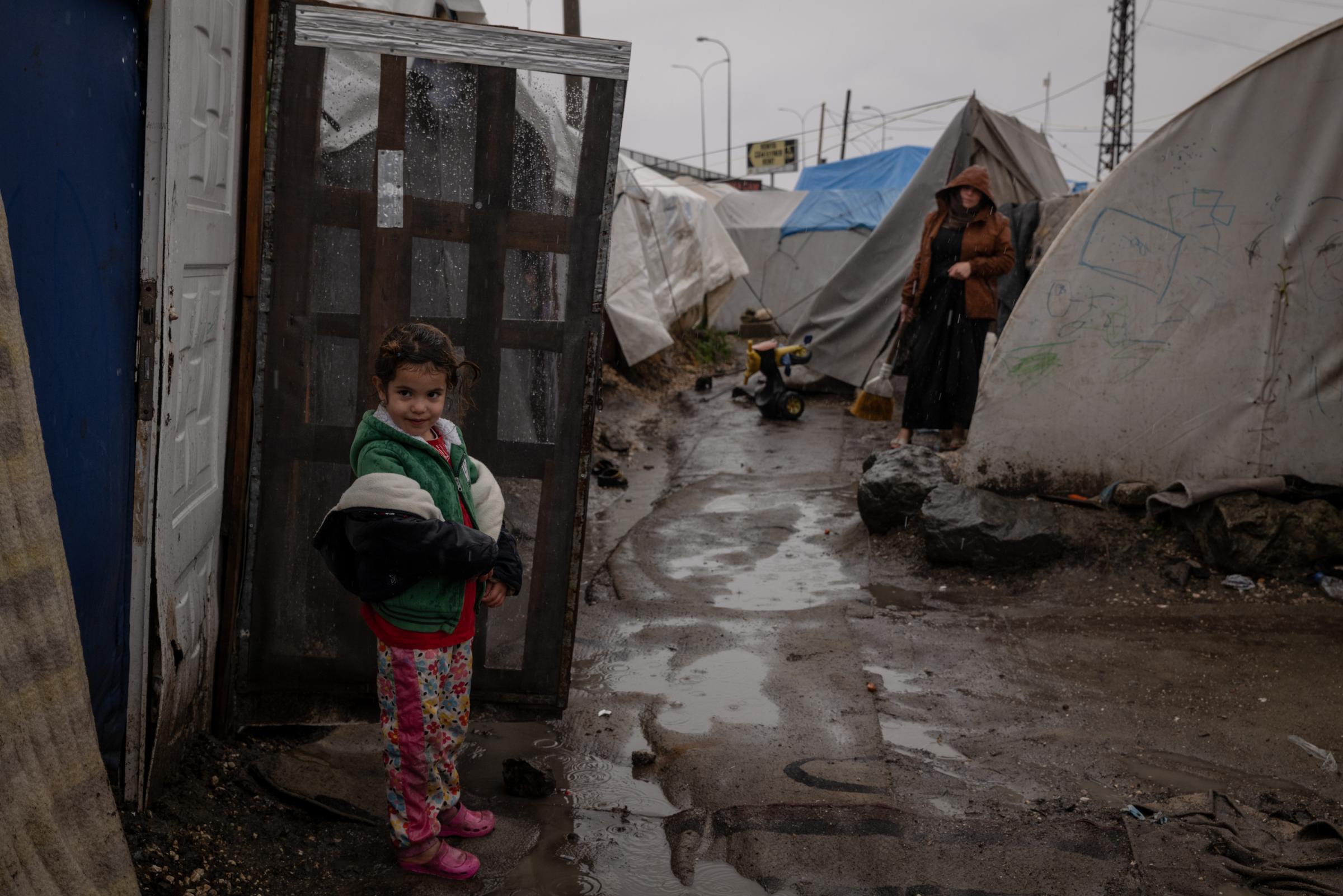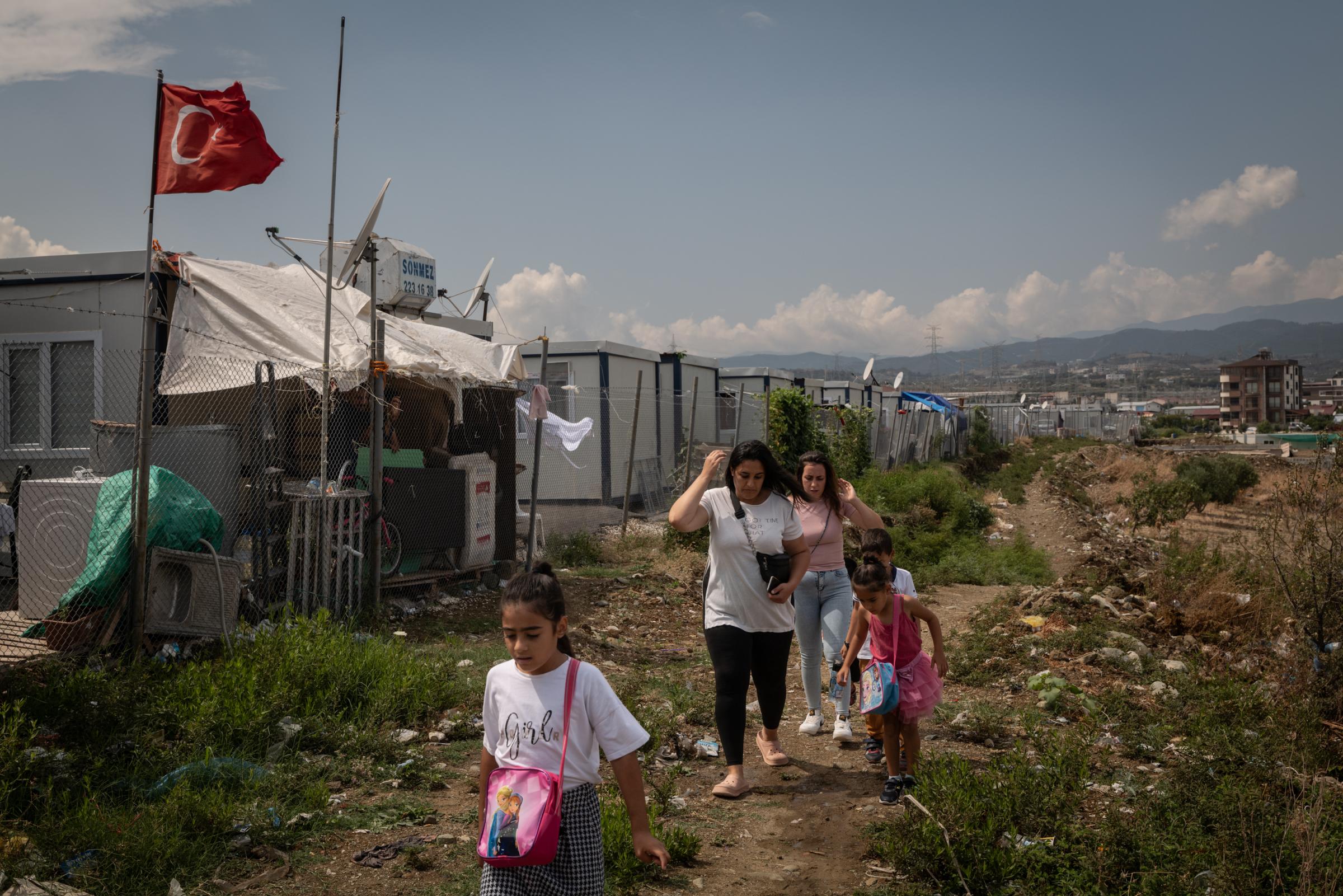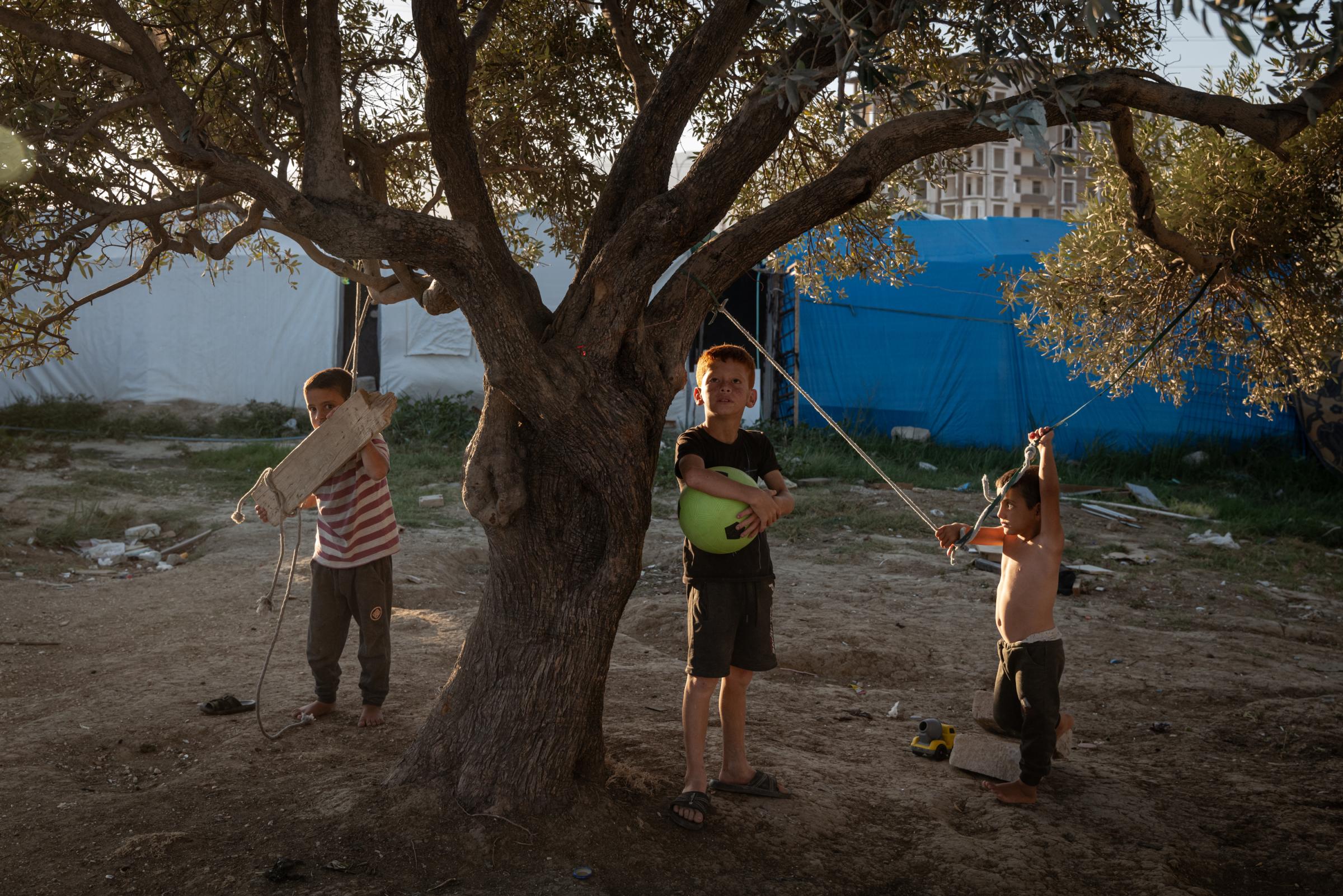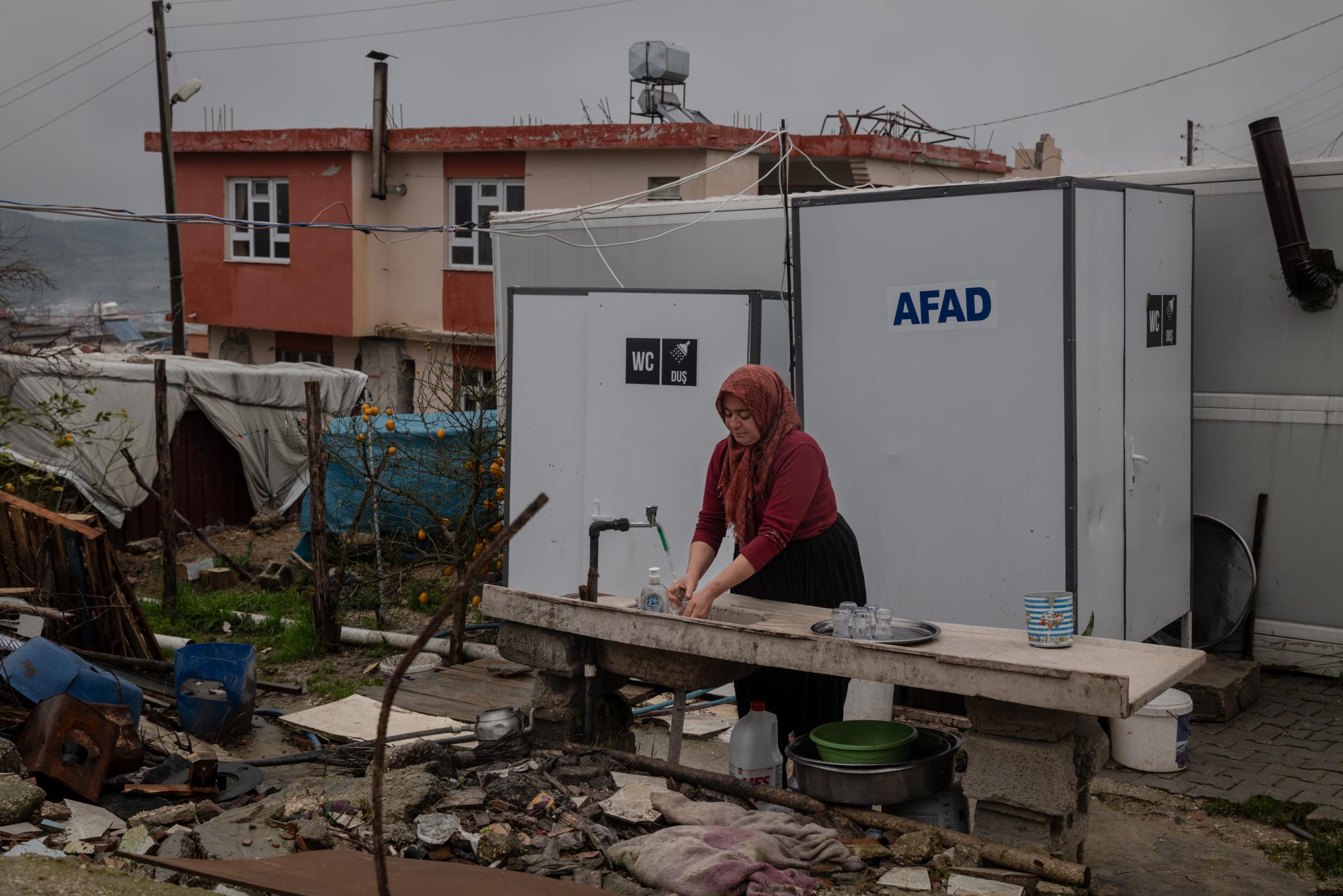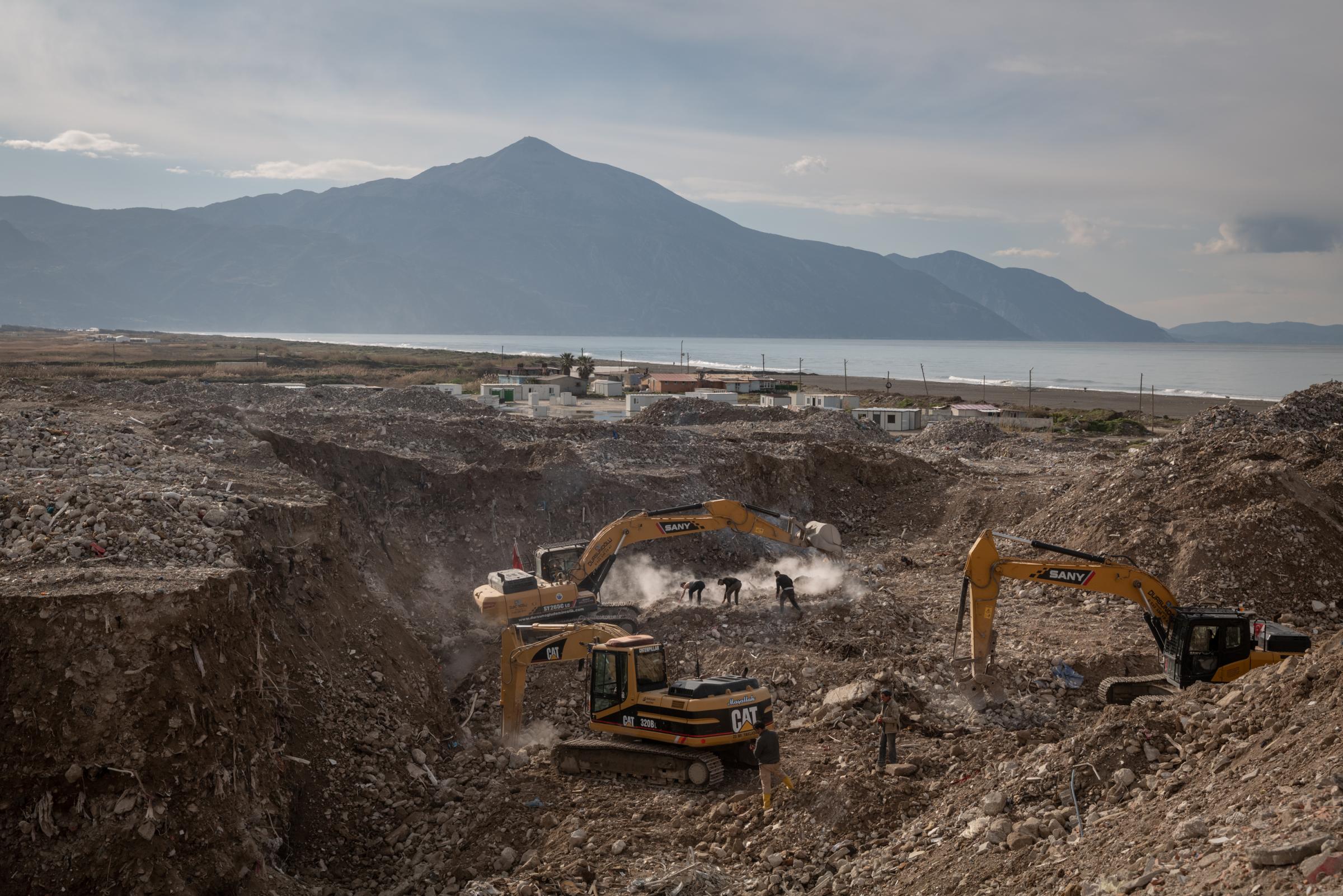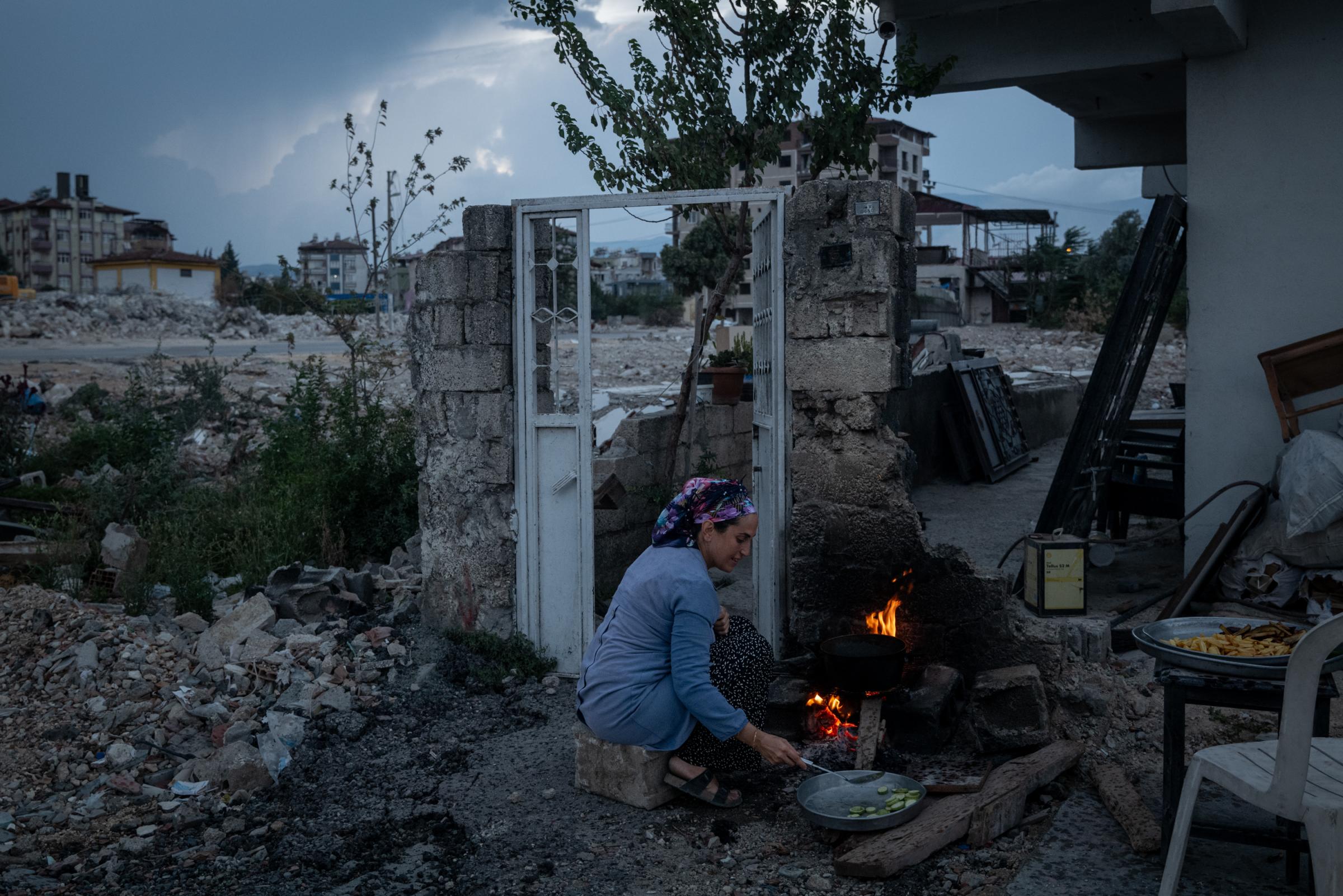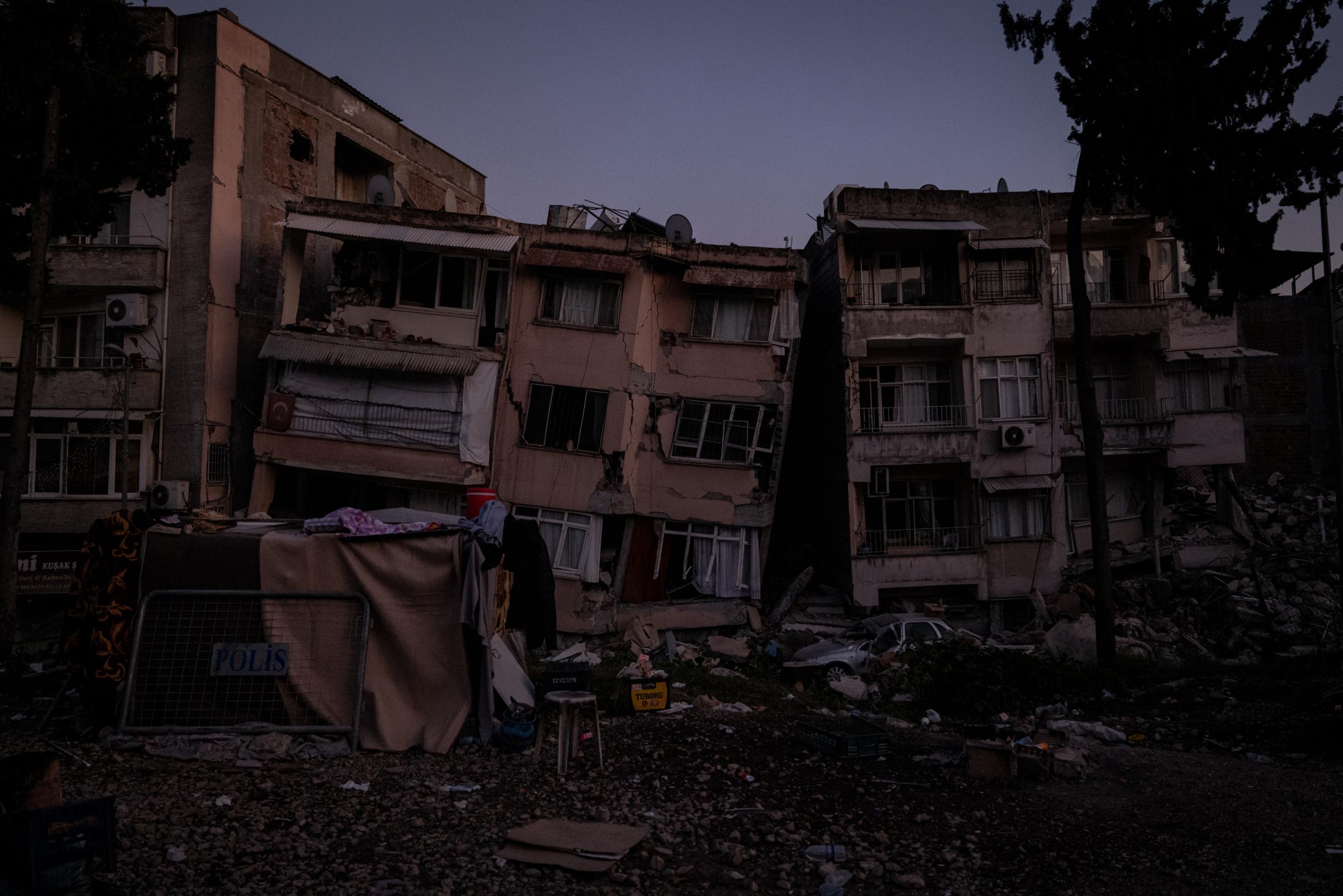A woman was comforted by a relative as the body of her mother was retrieved from the rubble in Antakya, Turkey, on Wednesday, February 15, 2023, following twin earthquakes on February 6 which have now claimed the lives of 50,000 people in Turkey and Syria.
Construction workers are seen at the site of where a shopping mall was located, as it undergoes demolition, in Antakya, Turkey, on Sunday, January 28, 2024. On February 6, 2023, twin earthquakes struck southern Turkey and northern Syria, killing over 52,000 people and displacing millions. Aftershocks continued on for months. Nearly one year on, recovery is ongoing, and temporary measures for housing the displaced are taking on an air of permanence as locals struggle to rebuild their lives. Hatay, and its provincial capital of Antakya, with a history dating back thousands of years, was devastated.
Displaced residents, taking shelter in a tent camp, lined up for a clothing and other aid during a distribution in Iskenderun, Turkey, on Tuesday, February 14, 2023.
A woman looked on amid the devastation of Antakya, Turkey. February 2023.
A resident salvaged whatever belongings she could from her destroyed home in Antakya, Turkey, on Friday, February 17, 2023. Two major earthquakes struck Turkey and Syria on February 6, claiming the lives of over 50,000 people, and displacing millions.
Necmiye Feliz (center, in black), 52, cried as she recalled the loss of her daughter Sevda, granddaughter Belinda, who was six, and her son-in-law Mehmet, in the February earthquakes, in Samandag, Hatay region, Turkey, on Wednesday, September 13, 2023. The remaining family now shelter in tents pitched inside a bazaar. Hatay region and its main city Antakya, sustained some of the heaviest damage during the twin earthquakes on February 6 earlier this year, which struck a large swathe of southern Turkey and parts of north west Syria. The death toll reached over 50,000, and at least 3 million people were displaced in the initial weeks after the earthquake, according to the International Organization for Migration. Thousands are now residing in container camps quickly erected by Turkish government aid agencies, but many are still waiting for more permanent shelter including thousands of Syrian refugees who remain in tents.
The bodies of three people recovered from the rubble are seen near a site where rescuers continued searching for people, in Antakya, Turkey, on Tuesday, February 14, 2023. More than 50,000 people died and over 1 million people were displaced in the immediate aftermath of the earthquakes on February 6.
Gulbahar Bicer, 35, holds her son Deniz, 5, while her other son Ali, 10, tends watches fire outside their tent shelter in Iskenderun, Turkey, on Thursday, February 16, 2023. The single mother of the children, Gulbahar, lost her home in the major earthquakes which hit Turkey and Syria on February 6. Ms. Bicer says that her application for a tent from a Turkish organization is still being processed. In the mean time, she is caring for her three children and mother-in-law by herself, living in a tent on the side of a main road in Iskenderun. Ms. Bicer says her son Deniz is experiencing panic attacks after the earthquake, and keeping her children clean without running water or electricity is the biggest challenge.
A drone image shows what remains of a part of the center of Antakya, Turkey, on Tuesday, September 12, 2023. Most buildings will be demolished as they sustained heavy damage in February’s earthquakes. The empty lots are where residences, offices, shops, and restaurants previously stood, which have since been demolished and their rubble removed.
Hatay region and its main city Antakya, sustained some of the heaviest damage during the twin earthquakes on February 6 earlier this year, which struck a large swathe of southern Turkey and parts of north west Syria. The death toll reached over 50,000, and at least 3 million people were displaced in the initial weeks after the earthquake, according to the International Organization for Migration. Thousands are now residing in container camps quickly erected by Turkish government aid agencies, but many are still waiting for more permanent shelter including thousands of Syrian refugees who remain in tents.
Hatay region and its main city Antakya, sustained some of the heaviest damage during the twin earthquakes on February 6 earlier this year, which struck a large swathe of southern Turkey and parts of north west Syria. The death toll reached over 50,000, and at least 3 million people were displaced in the initial weeks after the earthquake, according to the International Organization for Migration. Thousands are now residing in container camps quickly erected by Turkish government aid agencies, but many are still waiting for more permanent shelter including thousands of Syrian refugees who remain in tents.
A man is seen on the back of a truck loaded with furniture, to be transported elsewhere, in Antakya, Turkey, on Thursday, January 11, 2024.
Sinem Can, 28, held her father Hilal Cam, 75, in the tent camp area where they are now living, after their house was destroyed in the February 6 earthquakes, in Samandag, Turkey, on Sunday, April 16, 2023. Over 50,000 people died in the February 6 twin earthquakes, which struck Turkey and Syria. At least one million people have been displaced, and many towns and cities in Turkey were reduced to rubble in the aftermath. In Samandag, which is a political opposition stronghold populated mostly by Turkish Alevis, rubble cleared from damaged and destroyed buildings is being dumped among residential areas where survivors are living in tent camps, and into environmentally sensitive sites near water sources potentially contaminating them. The mountains of rubble next to the water sources is also disrupting bird migration patterns. That has prompted local and activists to protest against what they see as irresponsible rubble removal, with potentially deadly consequences - including cancer - from asbestos, and thousands of other household chemicals being released into the air constantly.
The interior of a mosque damaged in February’s earthquake, in Antakya, Turkey, on Wednesday, September 13, 2023.
Members of multiple Syrian refugee families gathered in a tent in Antakya, Turkey, on Wednesday, January 10, 2024. The families were displaced by last year’s twin earthquakes, once again landing them in tents, similar to the ones they first lived in when fleeing the war in Syria in 2011.
Workers removed gas cylinders from the grounds of the Palladium Shopping Center, undergoing demolition following last year’s earthquakes, in Antakya, Turkey, on Tuesday, January 9, 2024.
Syrian families are seen in a tent camp with subpar conditions, where they have been residing for nearly a year since last year’s earthquakes, in Antakya, Turkey, on Friday, January 26, 2024.
Parents walked their children from a container camp for the displaced, to their temporary school located in a prefab building, on the first day of school in Defne, a district of Hatay region, Turkey, on Monday, September 11, 2023. Hatay region and its main city Antakya, sustained some of the heaviest damage during the twin earthquakes on February 6 earlier this year, which struck a large swathe of southern Turkey and parts of north west Syria. The death toll reached over 50,000, and at least 3 million people were displaced in the initial weeks after the earthquake, according to the International Organization for Migration. Thousands are now residing in container camps quickly erected by Turkish government aid agencies, but many are still waiting for more permanent shelter including thousands of Syrian refugees who remain in tents.
Children from Syrian families played outside their tents in Antakya, Turkey, on Wednesday, September 13, 2023. Hatay region and its main city Antakya, sustained some of the heaviest damage during the twin earthquakes on February 6 earlier this year, which struck a large swathe of southern Turkey and parts of north west Syria. The death toll reached over 50,000, and at least 3 million people were displaced in the initial weeks after the earthquake, according to the International Organization for Migration. Thousands are now residing in container camps quickly erected by Turkish government aid agencies, but many are still waiting for more permanent shelter including thousands of Syrian refugees who remain in tents.
A displaced woman washed dishes near her container shelter in the village of Tepehan, Turkey, on Friday, January 26, 2024. Since last year’s earthquakes, most people are too afraid to live in their houses even if there was only minor damage, while others have no option but to live in tents or containers they have often purchased, if outside a government-run container camp.
Excavators sorted debris at a massive rubble dump site located near the shore, and on the path of migratory birds, in Samandag, Turkey, on Saturday, January 27, 2024. Following last year’s devastating earthquakes, rubble from both Samandag and other towns and villages have been brought to this dump site where the rubble is sorted for its metal and other materials. Residents and environmental activists have rallied to protest against the dump site, which they say has caused numerous health conditions as a result of the toxic dust released into the air. Migratory birds who stop here on their way back to the African continent and Arabia have also been disrupted, as the wetlands located at the dump site have been shrinking as more waste and debris encroach on it.
Canan Içer, 41, cooked dinner on a wood-fired stove outside her home in Antakya, Turkey, on Monday, September 11, 2023. Ms. Icer, with her husband and five children, remained in the city after February’s twin earthquakes, as their house was one of the few that sustained little damage. Hundreds of other structures around them crumbled, or have since been demolished, according to the family, and they lost approximately 400 people in the immediate area alone including neighbors. Ms. Icer cooked outside to avoid using a gas stove, as gas prices have risen.
Destroyed buildings in Antakya, Turkey, February 15, 2023.
